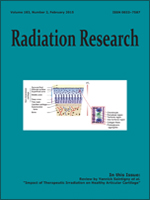Dosimetic uncertainties, particularly those that are shared among subgroups of a study population, can bias, distort or reduce the slope or significance of a dose response. Exposure estimates in studies of health risks from environmental radiation exposures are generally highly uncertain and thus, susceptible to these methodological limitations. An analysis was published in 2008 concerning radiation-related thyroid nodule prevalence in a study population of 2,994 villagers under the age of 21 years old between August 1949 and September 1962 and who lived downwind from the Semipalatinsk Nuclear Test Site in Kazakhstan. This dose-response analysis identified a statistically significant association between thyroid nodule prevalence and reconstructed doses of fallout-related internal and external radiation to the thyroid gland; however, the effects of dosimetric uncertainty were not evaluated since the doses were simple point “best estimates”. In this work, we revised the 2008 study by a comprehensive treatment of dosimetric uncertainties. Our present analysis improves upon the previous study, specifically by accounting for shared and unshared uncertainties in dose estimation and risk analysis, and differs from the 2008 analysis in the following ways: 1. The study population size was reduced from 2,994 to 2,376 subjects, removing 618 persons with uncertain residence histories; 2. Simulation of multiple population dose sets (vectors) was performed using a two-dimensional Monte Carlo dose estimation method; and 3. A Bayesian model averaging approach was employed for evaluating the dose response, explicitly accounting for large and complex uncertainty in dose estimation. The results were compared against conventional regression techniques. The Bayesian approach utilizes 5,000 independent realizations of population dose vectors, each of which corresponds to a set of conditional individual median internal and external doses for the 2,376 subjects. These 5,000 population dose vectors reflect uncertainties in dosimetric parameters, partly shared and partly independent, among individual members of the study population. Risk estimates for thyroid nodules from internal irradiation were higher than those published in 2008, which results, to the best of our knowledge, from explicitly accounting for dose uncertainty. In contrast to earlier findings, the use of Bayesian methods led to the conclusion that the biological effectiveness for internal and external dose was similar. Estimates of excess relative risk per unit dose (ERR/Gy) for males (177 thyroid nodule cases) were almost 30 times those for females (571 cases) and were similar to those reported for thyroid cancers related to childhood exposures to external and internal sources in other studies. For confirmed cases of papillary thyroid cancers (3 in males, 18 in females), the ERR/Gy was also comparable to risk estimates from other studies, but not significantly different from zero. These findings represent the first reported dose response for a radiation epidemiologic study considering all known sources of shared and unshared errors in dose estimation and using a Bayesian model averaging (BMA) method for analysis of the dose response.
How to translate text using browser tools
9 January 2015
Accounting for Shared and Unshared Dosimetric Uncertainties in the Dose Response for Ultrasound-Detected Thyroid Nodules after Exposure to Radioactive Fallout
Charles E. Land,
Deukwoo Kwon,
F. Owen Hoffman,
Brian Moroz,
Vladimir Drozdovitch,
André Bouville,
Harold Beck,
Nicholas Luckyanov,
Robert M. Weinstock,
Steven L. Simon
ACCESS THE FULL ARTICLE

Radiation Research
Vol. 183 • No. 2
February 2015
Vol. 183 • No. 2
February 2015




